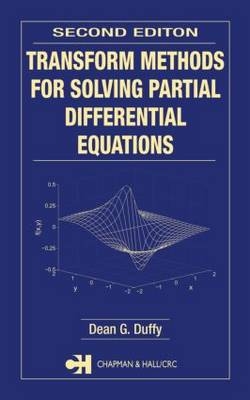
Transform Methods for Solving Partial Differential Equations
Seiten
2004
|
2nd edition
Chapman & Hall/CRC (Verlag)
978-1-58488-451-4 (ISBN)
Chapman & Hall/CRC (Verlag)
978-1-58488-451-4 (ISBN)
Illustrates the use of Laplace, Fourier, and Hankel transforms to solve partial differential equations encountered in science and engineering. This edition provides a broader perspective on the applicability and use of transform methods. It offers a step-by-step analysis of problems taken from the actual scientific and engineering literature.
Transform methods provide a bridge between the commonly used method of separation of variables and numerical techniques for solving linear partial differential equations. While in some ways similar to separation of variables, transform methods can be effective for a wider class of problems. Even when the inverse of the transform cannot be found analytically, numeric and asymptotic techniques now exist for their inversion, and because the problem retains some of its analytic aspect, one can gain greater physical insight than typically obtained from a purely numerical approach.
Transform Methods for Solving Partial Differential Equations, Second Edition illustrates the use of Laplace, Fourier, and Hankel transforms to solve partial differential equations encountered in science and engineering. The author has expanded the second edition to provide a broader perspective on the applicability and use of transform methods and incorporated a number of significant refinements:
New in the Second Edition:
· Expanded scope that includes numerical methods and asymptotic techniques for inverting particularly complicated transforms
· Discussions throughout the book that compare and contrast transform methods with separation of variables, asymptotic methods, and numerical techniques
· Many added examples and exercises taken from a wide variety of scientific and engineering sources
· Nearly 300 illustrations--many added to the problem sections to help readers visualize the physical problems
· A revised format that makes the book easier to use as a reference: problems are classified according to type of region, type of coordinate system, and type of partial differential equation
· Updated references, now arranged by subject instead of listed all together
As reflected by the book's organization, content, and many examples, the author's focus remains firmly on applications. While the subject matter is classical, this book gives it a fresh, modern treatment that is exceptionally practical, eminently readable, and especially valuable to anyone solving problems in engineering and the applied sciences.
Transform methods provide a bridge between the commonly used method of separation of variables and numerical techniques for solving linear partial differential equations. While in some ways similar to separation of variables, transform methods can be effective for a wider class of problems. Even when the inverse of the transform cannot be found analytically, numeric and asymptotic techniques now exist for their inversion, and because the problem retains some of its analytic aspect, one can gain greater physical insight than typically obtained from a purely numerical approach.
Transform Methods for Solving Partial Differential Equations, Second Edition illustrates the use of Laplace, Fourier, and Hankel transforms to solve partial differential equations encountered in science and engineering. The author has expanded the second edition to provide a broader perspective on the applicability and use of transform methods and incorporated a number of significant refinements:
New in the Second Edition:
· Expanded scope that includes numerical methods and asymptotic techniques for inverting particularly complicated transforms
· Discussions throughout the book that compare and contrast transform methods with separation of variables, asymptotic methods, and numerical techniques
· Many added examples and exercises taken from a wide variety of scientific and engineering sources
· Nearly 300 illustrations--many added to the problem sections to help readers visualize the physical problems
· A revised format that makes the book easier to use as a reference: problems are classified according to type of region, type of coordinate system, and type of partial differential equation
· Updated references, now arranged by subject instead of listed all together
As reflected by the book's organization, content, and many examples, the author's focus remains firmly on applications. While the subject matter is classical, this book gives it a fresh, modern treatment that is exceptionally practical, eminently readable, and especially valuable to anyone solving problems in engineering and the applied sciences.
Dean G. Duffy
The Fundamentals. Methods Involving Single-Valued Transforms. Methods Involving Multivalued Transforms. The Joint Transform Method. The Wiener-Hopf Technique. Worked Solutions to Some of the Problems. Index.
| Erscheint lt. Verlag | 19.10.2018 |
|---|---|
| Reihe/Serie | Symbolic & Numeric Computation |
| Zusatzinfo | 7 Tables, black and white; 294 Illustrations, black and white |
| Sprache | englisch |
| Maße | 156 x 234 mm |
| Gewicht | 1124 g |
| Themenwelt | Mathematik / Informatik ► Mathematik ► Analysis |
| ISBN-10 | 1-58488-451-7 / 1584884517 |
| ISBN-13 | 978-1-58488-451-4 / 9781584884514 |
| Zustand | Neuware |
| Haben Sie eine Frage zum Produkt? |
Mehr entdecken
aus dem Bereich
aus dem Bereich
Band 5: Hydraulik, Stromfadentheorie, Wellentheorie, Gasdynamik
Buch | Softcover (2024)
De Gruyter Oldenbourg (Verlag)
59,95 €


